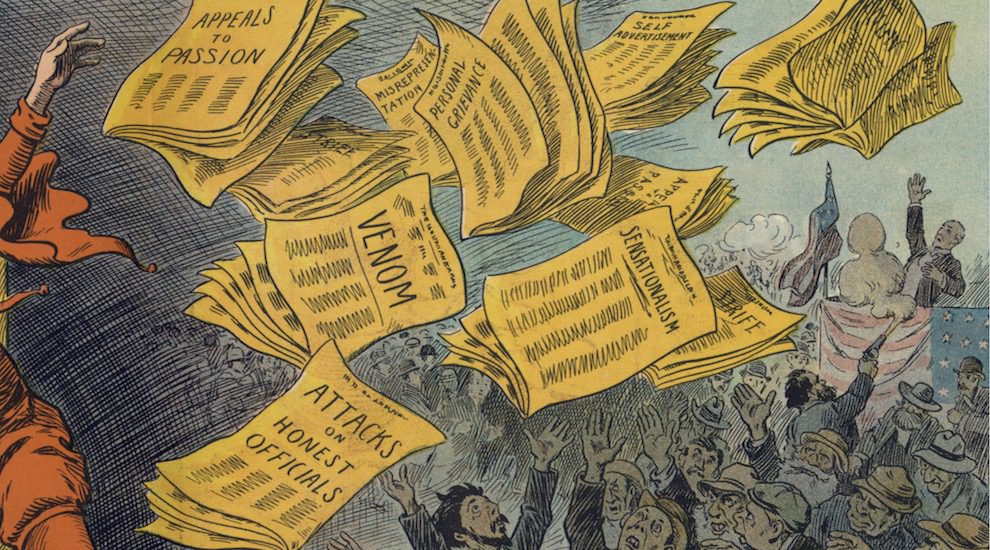
, for NiemanLab
“Persistent debates about what constitutes ‘fake news’ and distinctions between other types of false information are mostly distracting.” Plus: A guide to covering misinformation without burning your news org or your readers, and a discussion of filter bubbles as not-really-a-thing.
“Focus on the most pressing questions to which we truly need answers.” In a paper to be published in an upcoming issue of American Behavioral Scientist, Brian Weeks, an assistant professor at the University of Michigan, and Homero Gil de Zúñiga of the University of Vienna outline the “critical issues” that they hope political communications research will focus on in the future. “We would like this article to serve as a call to the growing number of political communication researchers who are investigating questions related to political misinformation to push themselves, think creatively, and focus on the most pressing questions to which we truly need answers,” they write. Among their observations:
— “Persistent debates about what constitutes ‘fake news’ and distinctions between other types of false information are mostly distracting.” False information is for sure a complex concept but spending too much time on hierarchies and definitions is a waste, the authors argue:
Instead of spending endless time and money arguing over the term fake news or trying to sort out what the minute differences between different types of false information are, we should focus on what really matters. We should recognize that misleading information is out there, we are being exposed to it, and it might be affecting us. If we really want to tackle this problem, let’s focus on where false information comes from, how it spreads, whether and why people believe it, and its social and political consequences.
— “To what extent does false information actually matter politically? Who is exposed to it, where, and to what effect?” We still don’t fully understand “how frequently people encounter false information in their everyday lives,” or how much it matters when they do — and “one thing we as a research community have not done well is actually document the effects of (or lack thereof) this type of bad information on outcomes we care about like voting, polarization, the rise of white nationalism, or echo chambers.”
— “Politicians, elites, and government officials are major (but understudied) sources of false information.” Put aside the trolls and random Twitter folk for a second — more study is needed on the effects of what comes out of well-known politicians’ mouths.
Regardless of whether people believe these claims, do members of the public respond to this information with more incivility, by becoming more engaged, or by ultimately becoming more polarized? These are important questions that misinformation researchers are primed to answer. So far these questions have been primarily set aside in favor of other sources of misinformation, but examining how politicians and elites spread misinformation and to what effect is one of the most needed topics of research.
The full paper (with three more observations) is here.
“Where possible, have we led with the truth?” First Draft News has published a new guide, “Responsible Reporting in the Age of Information Disorder.” The guide, written by First Draft ethics and standards editor Victoria Kwan, is aimed at news organizations and reporters “facing an array of new ethical challenges relating specifically to amplification.” Among the takeaways from the report:— Get your timing right, and consider whether the story actually needs to be covered by you: “If the content you are considering covering is being discussed or circulated only in niche communities, writing about it may actually spread it to a much wider audience.” It’s also possible, of course, to get to a story too late; “Newsrooms, then, must identify a ‘tipping point’ at which mis- and disinformation becomes beneficial to address,” and while that point can vary, it’s generally when a story has moved off a niche platform into the broader community.
— Ask yourself questions when covering manipulated content:
— When deciding whether to cover manipulated content, have we considered how far and how quickly the content has already spread, and its predicted virality and impact?
— If we choose to feature a manipulated video in my reporting, have we thought about using selected clips or images instead of embedding or linking to the original (while being mindful of any additional copyright considerations)?
— Can we overlay the manipulated content with graphics or text that clearly inform audiences of how the video has been manipulated?
— Have we thought about the language we are using to describe this type of disinformation? It may be useful to explain that the content is “altered,” “manipulated” or “distorted,” rather than to say that it is “fake”, which may be confusing to readers especially when the disinformation is based on genuine photos or videos.
— Where possible, have we led with the truth and avoided repeating or amplifying the intended outcome or accusatory language in the headline?
— Have we provided context and presented the existence of a piece of content within a bigger picture relating to intentions, motivations, threat and harm?
— Before referring to a falsehood, have we provided an explanation of why it is false and evidence to support verified conclusions?
— Have we taken care not to undermine or make fun of those who believe the manipulated content? Doing so can lead to a hardening of these beliefs.
Five questions to help us report responsibly in an age of information disorder. Read the full guide: https://t.co/cK8fkISVBb pic.twitter.com/emtmgd61n5
— First Draft (@firstdraftnews) October 7, 2019
How can we report on dubious or fake websites without boosting their search rank?
No-follow links direct readers to a site, but prevent the site from climbing up search results.Find out more in our new guide to responsible reporting. https://t.co/cK8fkISVBb pic.twitter.com/oHCChXuDfg
— First Draft (@firstdraftnews) October 8, 2019
“News of our bloated, biased media diets has been greatly exaggerated.” Some more evidence to suggest that filter bubbles aren’t as big a problem as commonly conceived: Maggie Koerth-Baker (a 2015 Nieman Fellow) writes in FiveThirtyEight about recent research from Dartmouth’s Brendan Nyhan and others that finds that Americans aren’t as politically isolated as they might appear (though some of them just aren’t really reading news at all):
Consider, for instance, the simple math of TV ratings. There are about 122 million Americans who told the Census Bureau that they voted in 2018. The vast majority of those voters don’t watch partisan cable news. FOX News and MSNBC pull in around 3 million viewers when their top hosts are on air. In contrast, around 5 million people tune in to each of the network nightly news shows. More Americans have a centrist media diet than a slanted one. And most Americans are basically fasting.
Featuring our @knightfdn white paper:
Avoiding the Echo Chamber About Echo Chambers: Why Selective Exposure To Like-Minded Political News Is Less Prevalent Than You Think https://t.co/3OReZ5CAmB
+findings from our research on “fake news” exposure in 2016 https://t.co/vgN74hX7e2 https://t.co/Rf76DTj5SG
— Brendan Nyhan (@BrendanNyhan) October 9, 2019
, for NiemanLab




